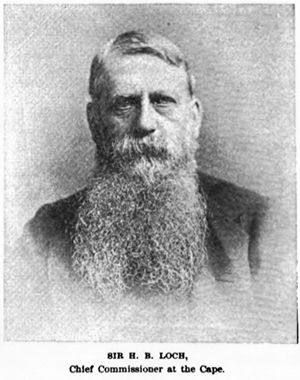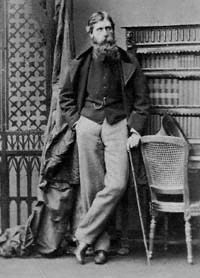Henry Loch, 1st Baron Loch facts for kids
Quick facts for kids
The Lord Loch
|
|
|---|---|

|
|
| Lieutenant Governor of the Isle of Man | |
| In office 1863–1882 |
|
| Monarch | Queen Victoria |
| Preceded by | Francis Conant |
| Succeeded by | Spencer Walpole |
| Governor of Victoria | |
| In office 1884–1889 |
|
| Monarch | Queen Victoria |
| Preceded by | Marquess of Normanby |
| Succeeded by | Earl of Hopetoun |
| High Commissioner for Southern Africa | |
| In office 1889–1895 |
|
| Monarch | Victoria |
| Preceded by | Sir Hercules Robinson |
| Succeeded by | The Lord Rosmead |
| Personal details | |
| Born |
Henry Brougham Loch
23 May 1827 |
| Died | 20 June 1900 (aged 73) London, England |
| Nationality | British |
| Spouse | Elizabeth Villiers |
| Military service | |
| Branch/service | British East India Company |
| Battles/wars | First Anglo-Sikh War Crimean War Second Opium War |
Henry Brougham Loch (born May 23, 1827 – died June 20, 1900) was an important British soldier and leader. He worked in many different parts of the world. He was known for his work as a colonial administrator. This means he helped manage British territories far from home. Later, he became known as the 1st Baron Loch.
Contents
Early Military Career
Henry Loch was the son of James Loch, a Member of Parliament. He first joined the Royal Navy. After two years, he left to join the British East India Company's army. In 1842, he became an officer in the Bengal Light Cavalry.
Serving in India and Crimea
During the First Anglo-Sikh War (1845–1846), he worked for Sir Hugh Gough. He served throughout the Sutlej campaign in India. In 1852, he became an adjutant, which is a staff officer, for Skinner's Horse.
When the Crimean War began in 1854, Loch left India. He was given permission to create a group of irregular Bulgarian cavalry. He led this group throughout the war.
Missions to East Asia
In 1857, Loch became an assistant to Lord Elgin. Lord Elgin was on a special mission to East Asia. Loch was present when the city of Canton (Guangzhou) was captured during the Second Opium War. In 1858, he brought home the Treaty of Yedo. This was an important agreement between Britain and Japan.
In April 1860, Loch went with Lord Elgin to China again. He was the secretary for a new group sent to make sure China followed its treaty agreements. This group was supported by British and French forces. Loch helped negotiate the surrender of the Taku Forts (Dagu Forts).
Captured in China
As the forces moved towards Peking (Beijing), Loch and Harry Smith Parkes were chosen for peace talks. They went to Tungchow (now Tongzhou District, Beijing) with a small group. They discovered that the Chinese were planning an attack. Loch rode back to warn the British forces.
He then returned to Parkes and his group under a flag of truce. This is a sign of peace. However, they were all captured by the Chinese general Sengge Rinchen. They were put in prison in Beijing. Many of the group died from torture or illness. Parkes and Loch were treated better after Prince Gong stepped in. After three weeks, they were released. They were freed just minutes before the emperor ordered their execution.
Personal Life
In 1862, Henry Loch married Elizabeth Villiers. They had two daughters and one son. There is a story that he accidentally proposed to Elizabeth's twin sister, but he never admitted it.
Colonial Administrator Roles
Loch never fully recovered his health after his time in the Chinese prison. When he returned home, he received an honor called the Companion of the Order of the Bath. For a while, he worked as a private secretary.
Governor of the Isle of Man
In 1863, he was appointed Lieutenant Governor of the Isle of Man. During his time there, the local government, called the House of Keys, became an elected assembly. This meant people could vote for their representatives. The first railway line was also opened, and more tourists started visiting the island. This brought new wealth to the island. In 1880, he became a Knight Commander of the Bath.
Governor of Victoria, Australia
In 1882, Loch became a commissioner of woods and forests. Two years later, in 1884, he became the governor of the colony of Victoria in Australia.
High Commissioner for Southern Africa
In June 1889, Loch became the Governor of Cape Colony and High Commissioner for Southern Africa. This was a very important role. He had to use good judgment and be firm.
Dealing with the Boers
The Boers were Dutch settlers in South Africa. They were trying to stop Cecil Rhodes's plans to expand British influence north. They also wanted to control areas like Swaziland and Zululand. Loch strongly supported Rhodes. He told President Paul Kruger, the Boer leader, that British troops would stop any invasion of British-protected land. This stopped the Boer movement into Banyailand (1890–1891).
Loch also made an agreement with President Kruger in 1890 about Swaziland. The Boers gave up their claims to land north of the Transvaal. In return, they were allowed access to the sea at Kosi Bay. This was on the condition that the Transvaal joined the South African Customs Union.
Later Challenges
The Transvaal did not meet the conditions of the agreement. The government in Pretoria became more hostile. Loch then pushed for Britain to take control of the land east of Swaziland. This was the land where the Boer railway would need to pass to reach the sea. In March 1895, Britain announced it would annex these territories. President Kruger was very surprised and upset by this news.
Loch also had to step in when the "commandeering" issue arose in 1894. This issue made the Uitlanders (foreigners) in the Transvaal very angry. Loch traveled to Pretoria to talk with President Kruger. He managed to get the unfair rules removed. The next year, he strongly protested against a new voting law in the Transvaal.
By early 1895, the situation in South Africa was becoming very tense. Cecil Rhodes, who was then the prime minister of Cape Colony, wanted a stronger British policy. Loch felt he was not in agreement with his ministers. He returned home in March 1895, a few months before his term ended. In the same year, he was given the title of Baron Loch.
When the Second Boer War started in 1899, Loch helped raise a group of mounted soldiers. They were named Loch's Horse after him. He passed away in London on June 20, 1900. His son, Edward Douglas Loch, became the next Baron Loch.
Legacy
- The town of Loch, Victoria, Australia, is named after the 1st Baron Loch.
- A part of Douglas Promenade is named Loch Promenade in his memory.
- The Isle of Man Railway locomotive No.4 Loch is also named in his honor.
- Loch Street in Canberra, Australia, is named after him because he was Governor of Victoria.


